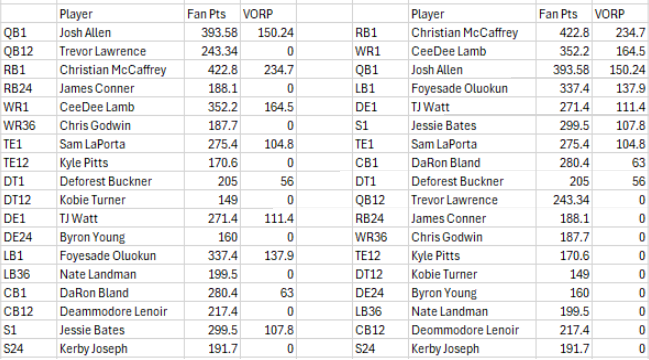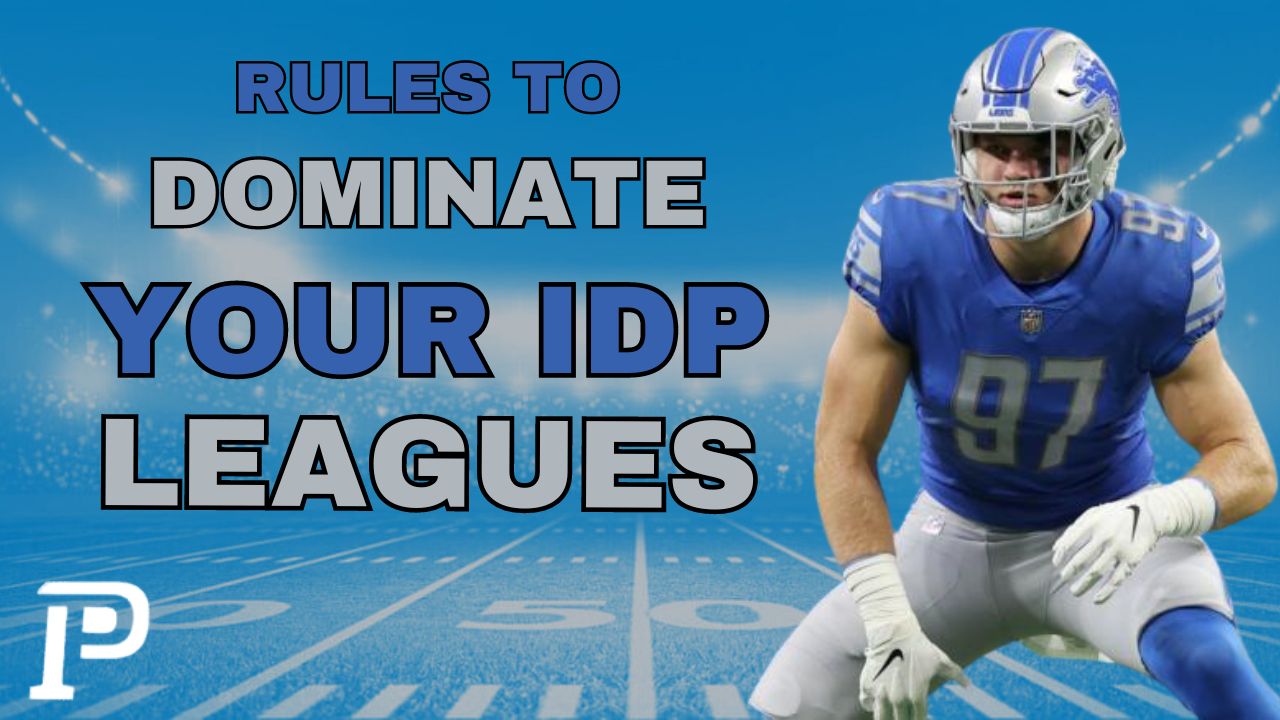PlayerProfiler is home to award-winning dynasty rankings and tools. Our Dynasty Deluxe package includes complete Dynasty Rankings, Rookie Rankings, Trade Analyzer, Draft Planner, Mock Drafts, and more. Check it out. Below, Aaron St. Denis breaks down his rules for dominating in a growing trend in fantasy football: IDP leagues.
As fantasy football has boomed in popularity and has swept the globe, we start to see a wider variety of leagues popping up. The vast majority of fantasy managers play in traditional leagues that focus on the offensive skill positions only. As managers get deeper down the rabbit hole, though, they gravitate to new and exciting formats they’ve never tried before. Many have decided to include both sides of the ball and branch out into IDP leagues. Here we take a look at five rules to dominate in IDP Leagues.
Before we get into the rules, let’s start with the basics. Roster composition is paramount and is the first thing to look at when drafting for IDP leagues, so that’s where we will start.
Setup for IDP Leagues
Much like regular fantasy football leagues, every IDP league is different. The key to being a successful manager is tailoring your draft strategy to fit the setting of your league, whether it be additional positions or a slight tweak in scoring settings.
I’m going to list the scoring and roster construction for a “typical” IDP league, but this will not be a one-size-fits-all section. Small changes to the format can make for massive swings in positional value, just as we’ve seen with tight-end premium or superflex leagues.
Rules to Dominate in IDP Leagues
1 – Roster Settings
Know your league’s roster settings to accurately determine how it impacts positional scarcity. The addition of even one starter can greatly alter the complexion of the league.
Casual Roster: 1 DL, 2 LB, 1 DB
This is your typical format for beginner IDP leagues. In a league like this where there are presumably twice as many offensive starters as defensive starters, it’s best to hold off on IDP and use late-round picks on them.
Intermediate Roster: 2 DL, 2 LB, 2 DB
Intermediate IDP leagues are typically only a few IDP players deeper, but that alone can have a huge impact on your draft strategy. While you won’t have to pull the trigger on drafting IDP players early in this configuration, you should consider drafting an elite defensive lineman the second you are no longer convinced by the quality of the offensive players left on the board. For me, that transition is typically in the 9th to 12th round range. By that point, you are drafting for depth and an elite lineman is a great value.
Once you draft an elite lineman, though, don’t feel compelled to go with only IDP picks from that point on, you can sprinkle in another lineman or linebacker, but it is still best to wait on defensive backs.
Expert Roster: 1 DT, 2 DE, 3 LB, 1 CB, 2 S
This format is by far the most in-depth and not only features extra IDP starting players but an added subdivision of positions. Note that DL has been split into DT and DE. Also, DB has been split into CB and S. These positions are not created equal and we will dive deeper into that in the positional setting section.
In this format, you will want to use your settings to calculate the relative value of each position. I use my baseball background and VORP (Value Over Replacement Player). For this, you factor in how many starters are at each position and weigh each player’s value against that of a replacement player.

Above is a representation of a basic VORP chart. It contains the top scorer at each position in comparison with the “replacement player” at their position. The replacement player is determined by roster size. In a 1QB, 12-team league QB12 would be the replacement quarterback, while in a league that starts three receivers, WR36 would be replacement level. We then compare the difference between the top player at the position and the replacement player and that gives us our VORP.
As we see above, in a 1QB league, defensive ends and linebackers are starting to elevate in value while defensive backs are viewed in the same range as tight ends.
2- Scoring Settings
Know your league’s scoring settings and how they skew the production for each specific position. Knowing which positions need an investment of high draft capital and on which you can wait is a key factor. The slightest deviation in scoring can completely change the landscape of a league and as scoring settings change, so does the value of each position.
Defensive Linemen
Considered the running back of IDP, defensive linemen are prime assets. They’re typically the first picks in IDP leagues. In deeper leagues, DL is divided into DE and DT. DEs are more valuable, contributing tackles and sacks. DTs rely heavily on sacks for fantasy relevance.
Linebackers
The linebacker position, in general, should be treated like the wide receiver position. There will always be outliers and top-end contributors, but for the most part, you can find usable linebackers deep into IDP drafts.
As you can see from the VORP chart above, linebackers such as Foyesade Oluokun tend to be the top scorers in IDP formats, but due to the depth of the position, it’s often wise to hold off on drafting them. Sure, you can load up on a guaranteed stud, but much like at receiver, there is always value to be had later, making linemen the priority.
Further consideration should be given if the league splits linebackers into outside and inside linebackers. In this scenario, ILBs tend to have higher tackle opportunities and a much higher ceiling while OLBs tend to rely more on sacks and turnovers.
Defensive Backs
The final IDP position is by far the least valuable in IDP leagues. Aside from leagues that play defensive tackles, no IDP position is less likely to produce at a high level. Defensive backs should be viewed as the tight ends of IDP. There are a few who can be solid contributors but they tend to get overdrafted and the rest are largely just average.
In non-expert fantasy leagues, big-name defensive backs go first, a mistake in IDP leagues. Shut-down corners have limited fantasy value. Opt for less-known defensive backs. They get more action. Even if beaten, they earn points for tackles.
If you play in a league that further splits defensive backs into cornerbacks and safeties, draft the safeties. Safeties are more likely to rack up high tackle numbers and interceptions while cornerbacks are more likely to compile passes defended.
3- Target Good Players on Bad Teams
It may sound counterintuitive to draft a good IDP player on a bad team, but in reality that’s exactly what you want. I want the star player whose team can’t score. He will be on the field early and often, giving him ample opportunity to produce. An IDP player can’t produce if the offense is on the field for 75 percent of the game.
This piggybacks on the above statement about shut-down corners. There is no value in players who don’t get opportunities. Target defenders who are on bad offenses and who will be involved in the action often.
4- Play the Matchups
In IDP leagues, matchups matter greatly, more so than in offense-only leagues. Consider a scenario like the Bills vs. Dolphins. Against a pass-happy Bills team, I prefer to start defensive backs who will see more volume. Assessing matchups is crucial in fantasy. Star players can perform in tough matchups, but their potential is restricted. In IDP leagues, avoid blindly starting top players.
5- Tackles are King
IDP leagues thrive on nuances, but tackles remain key. Players with high tackle counts prove valuable in fantasy, irrespective of position. Low tackles spell trouble. Tackle-premium leagues emphasize this further. Prioritize tackle producers, disregarding other stats.
Final Thought
Again, the key here is always to be sure of your roster and scoring settings. The general rules for player values are for basic leagues. As your settings change, so does the positional value. A simple thing like a double-the-tackle bonus will greatly skew the balance of the league. Always check your settings!
Player Profiler will be rolling out IDP Rankings for the 2024 season, so check back before you draft.
Read Jason Allwine’s breakdown on IDP leagues here: IDP 101: Everything You Need to Know About IDP Leagues


